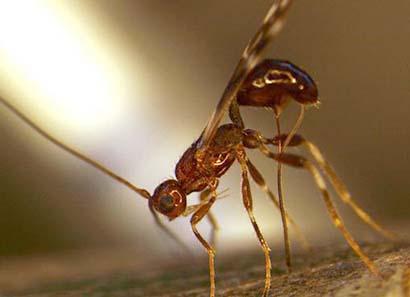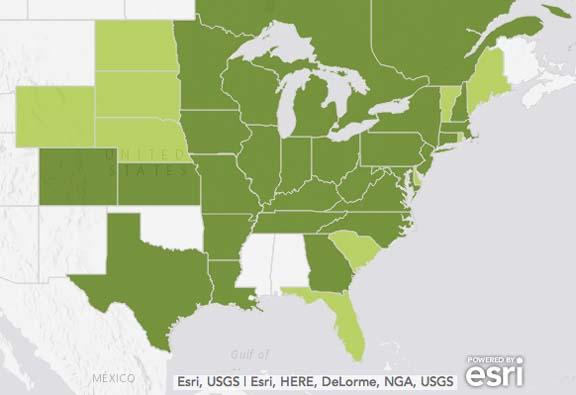Who knew a secret weapon could come in such a small package?
 The U.S. Department of Agriculture recently approved use of a fourth non-native parasitic wasp species in the fight to control the spread of emerald ash borer.
The U.S. Department of Agriculture recently approved use of a fourth non-native parasitic wasp species in the fight to control the spread of emerald ash borer.
Spathius galinae is a non-stinging parasitic wasp that is native to Russia. Like Asian parasitic wasp species such as Oobius agrili, Spathius agrili and Tetrastichus planipennisi that have been used to control EAB for at least two years, Spathius galinae is a natural predator of EAB in Russia and does not parasitise any other host.
Non-native parasitic wasps have proven to be effective at parasitizing 50-90 percent of the target EAB ova or larvae.
The wasps are raised at the USDA Animal and Plant Health Inspection Service facility in Michigan, and currently are used in 24 of the 25 states where EAB has been confirmed, according to the federal agency.
At least one species of wasp native to Asia, Spathius agrili, has not fared well in the United States. Researchers believe the climate here is too cold to sustain it, and the USDA has stopped raising it. Spathius galinae is thought to be better adapted to cold climates.
Since it was detected in the Detroit area in 2002, the emerald ash borer has spread like wildfire. Its presence has been confirmed in 25 states as well as the Canadian provinces of Ontario and Quebec.
According to the Web site EmeraldAshBorer.info, EAB's U.S. range extends from New Hampshire in the East, southward to Georgia and as far west as Texas and Colorado.
 States where EAB has been confirmed include Arkansas, Colorado, Connecticut, Georgia, Illinois, Indiana, Iowa, Kansas, Kentucky, Louisiana, Maryland, Massachusetts, Michigan, Minnesota, Missouri, New Hampshire, New Jersey, New York, North Carolina, Ohio, Tennessee, Texas, Virginia, West Virginia and Wisconsin. Its progress is being monitored in at least 10 other states.
States where EAB has been confirmed include Arkansas, Colorado, Connecticut, Georgia, Illinois, Indiana, Iowa, Kansas, Kentucky, Louisiana, Maryland, Massachusetts, Michigan, Minnesota, Missouri, New Hampshire, New Jersey, New York, North Carolina, Ohio, Tennessee, Texas, Virginia, West Virginia and Wisconsin. Its progress is being monitored in at least 10 other states.In the latest round of testing, scientists conducted research on 14 other beetle species to determine whether any were acceptable hosts for Spathius galinae. The only beetle affected, said researchers, was the gold spotted oak borer, another invasive species found in the U.S. only in Southern California.
Those interested in acquiring and releasing the parasitic wasps must have a release permit issued by the USDA, which has a host of recommendations for the size of the wooded area that has been affected, age of the trees involved and density of EAB population at the site.
EAB kills ash trees by disrupting the uptake of water and nutrients through the trunk and into the upper reaches of the tree.
Adult females, which grow to about a half-inch in length, create a hole in the bark into which they deposit their eggs. After hatching, the larvae feed on and chew galleries through the tissue beneath the bark layer, disrupting the tree's ability to move water and nutrients through its vascular system. In the spring, new adults chew through the bark and emerge, flying into the canopy to ingest ash leaves and the reproductive process begins all over again.
Symptoms of infestation include thinning of the canopy and sprouts growing from holes in the trunk that were created by the pests, along with an abundance of hungry woodpeckers that eat them. According to the Ohio Department of Agriculture, canopies of mature ash tree typically are decimated within two years of infestation and the trees dead within five years.
The wasps are barely larger than a flake of pepper, according to the USDA. The adult lays her eggs on a host larva. In the ultimate irony for the EAB, the wasps larva then feed on the host, eventually killing it.
EAB.info is a collaborative effort between Michigan State, Ohio State and Purdue universities; the Michigan and Ohio departments of agriculture; Indiana and Ohio departments of natural resources; the USDA-APHIS; U.S. Forest Service; and the Canadian Food Inspection Agency.

